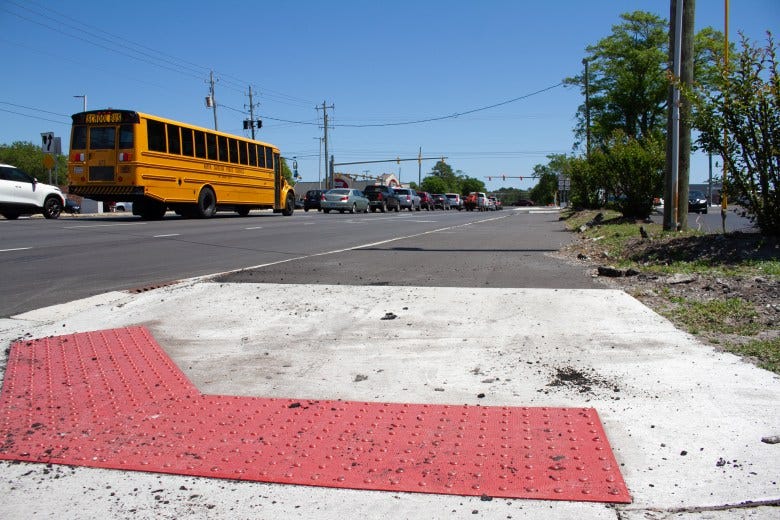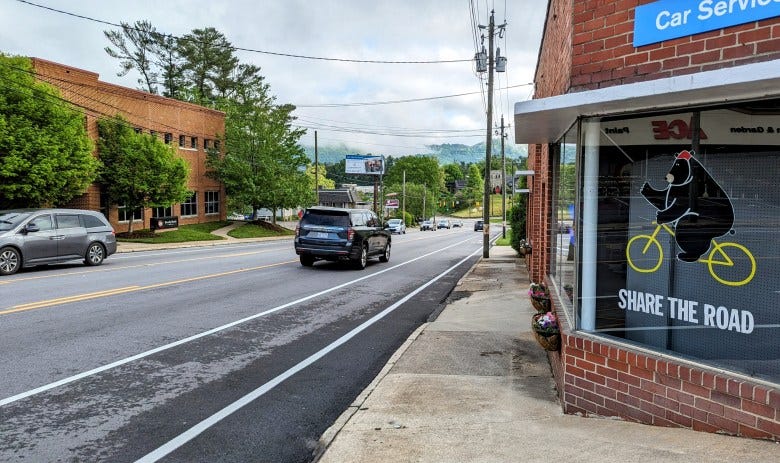A push for pedestrian-friendly roads
N.C. law restricts state funding for bike lanes and pedestrian projects
You’re reading Transit Time, a weekly newsletter for Charlotte people who leave the house. Cars, buses, light rail, bikes, scooters … if you use it to get around the city, we write about it. Transit Time is produced in partnership between The Charlotte Ledger and WFAE.
Editor’s note: The following is an excerpt of an article from The Assembly, a statewide digital magazine with thoroughly reported original articles about people and institutions in North Carolina. For the full article, and to find out more about The Assembly, go to TheAssemblyNC.com. You can also subscribe to The Assembly’s newsletter.
A decade-old state law prevents NCDOT from funding many projects to improve roads for walkers and cyclists. Local governments and bike advocates want to change that.
by Eric Barton
The Assembly
The first time the local news reported on Joshua Resseguie, it was a heartfelt story, the kind of piece that makes people feel better about the world.
Resseguie had been sleeping in his home in the Eastern North Carolina town of Rose Hill in March 2023 when his dog, Beau, busted through the door. “As soon as he did that, I saw the smoke rolling in,” Resseguie told television station WCTI.
Resseguie, who was mostly paralyzed, got into his wheelchair and managed to escape just minutes before the fire in the hallway would have made it impossible to exit. Beau was a hero.
Two months later, 39-year-old Resseguie and Beau made the news again. This time, a car struck Resseguie while he was traveling in his wheelchair with Beau along state Highway 210 in North Topsail Beach. Witnesses told police the car drifted into the shoulder. Beau wasn’t hurt, but Resseguie died.
Even though they didn’t know each other, news of Resseguie’s death hit Sam Boswell especially hard.
Boswell is director of the Cape Fear Rural Transportation Planning Organization, which helps draw up local roadway projects for Brunswick, Columbus, and Pender counties. The road where Resseguie was struck has no sidewalks — just a shoulder painted like a bike lane where cyclists, walkers and people using wheelchairs travel inches from cars. Boswell’s group, which was founded in 2001, had for years called for adding bike and pedestrian access along Highway 210.
“I can’t help but think,” Boswell said, “if we could have done more, there’s a chance that death was preventable.”
A new curb cut with no separation for pedestrians from the road in Wilmington. (Johanna F. Still for The Assembly)
One reason Highway 210 hasn’t been addressed: A North Carolina law passed in 2013 made it much harder to improve access for pedestrians and cyclists on state roads. The law says state funds can only go to such efforts if they’re part of projects that benefit drivers.
Bike and pedestrian advocates have been working for a decade to change that part of the Strategic Transportation Investments law, commonly called STI. They say it puts North Carolina cyclists and pedestrians in danger. A proposal before the state legislature in the short session, which began in April, seeks to rewrite the law to allow more state funds to be used for bike and pedestrian projects — but lawmakers have floated that before and never passed it.
…
Terry Lansdell had just begun his job as director of BikeWalk NC in 2018 when he sat down to read every North Carolina law regarding bike and pedestrian access.
He explains this with a laugh: “That is my nerdiness and wonkiness coming through. I don’t mind sitting down with the North Carolina general statutes and going through them.”
When Lansdell got to the STI law, something jumped out at him: “The Department shall not provide financial support for independent bicycle and pedestrian improvement projects.”
“What struck me was the phrase ‘shall not,’” Lansdell recalls.
What it means is this: State roadway funds must first and foremost improve access for cars. Lansdell says that means even state roads that are well known as dangerous for cyclists and pedestrians have little chance of seeing improvements — unless they’re tacked onto upgrades that help move cars.
Rep. Frank Iler, a Brunswick County Republican and one of the law’s co-sponsors, said he and his co-authors wanted to make sure voters weren’t picking up the tab for bike lane or sidewalk projects that didn’t affect them. “Whether you’re going to have bike lanes on every highway in the state, well, I don’t think that’s ever going to happen,” Iler said. “I drive in Raleigh a lot, and Raleigh has taken automobile lanes and turned them into bike lanes, and in a lot of cases, it adds a lot of confusion.”
Still, the restriction is frustrating for some local planners. While cities and counties can use their own money to improve city and county roads, they must ask the state to make improvements to state roadways. Federal funds can be used for bike and pedestrian upgrades on state roads, but those projects generally require a 20% contribution from state or local governments. Since 2013, the state can’t provide those funds for cyclist- or walker-only projects, and cities and counties usually can’t afford it.
Advocates say the need for better bike and pedestrian access is clear. The number of bicyclists and pedestrians killed on North Carolina streets rose to 289 in 2022, up 51% from 191 deaths in 2013, according to NCDOT.
Projects that were already underway were grandfathered in under the 2013 law. Lansdell says it’s impossible to say if the increase in deaths could have been prevented with more state roadway funds. But advocates and local planners say road improvements might help the situation, if they could get the money for them.
Tristan Winkler, director of the French Broad River Metropolitan Planning Organization in Asheville, one of 18 state-local partnerships that makes transportation decisions, says his group uses 97% of its discretionary funds on bike and pedestrian projects. Often, the organization has a bike and pedestrian project that’s been listed as a high priority, but without state funds to help pay for it, there’s no way to move forward.
Asheville recently added bike lanes along a portion of Merrimon Avenue, a major thoroughfare for the city’s north side. Improving bike and pedestrian access on Merrimon Avenue had appeared on the organization’s priority lists since 2008.
But those new lanes are just one piece of the city’s connected bike lane network that advocates would like to see grow. Residents in several neighborhoods still have no safe way to commute by bike or walk, said Mike Sule, founder and executive director of Asheville on Bikes.
Asheville recently added bike lanes along a portion of Merrimon Avenue, but that’s just one piece of the city’s connected bike lane network that advocates would like to see grow. (Eric Barton for The Assembly)
Similarly, in Wilmington, Gordon Road, also known as state Road 2048, has no crosswalks and a sidewalk only on one side of the street (a problem that is apparently common in Wilmington).
In northern Mecklenburg County, N.C. 73 is a hodgepodge of mismatched bike lanes and sidewalks, with interchanges that include limited or no access for anything but cars. The state is now considering widening the highway, but the proposal includes bike lanes and sidewalks in only a section of it.
Eric Barton is a freelance journalist who splits his time between Miami and Asheville, where he lives in a tiny cabin that was once the county poor house with his wife, Jill, and labradoodle, Finn. He has written for Garden & Gun, Men’s Health, and Outside.
The complete version of this article was originally published by The Assembly on May 6 and is excerpted with permission. You can read the complete article here.
In brief
Big road contract: The N.C. Department of Transportation awarded a contract worth more than $1 billion to build the I-26 Connector in Asheville. (Asheville Citizen-Times)
Spike in light rail passengers during music festival: Ridership on Charlotte’s Blue Line increased by 50% on the weekend of the Lovin’ Life Music Fest, interim CEO Brent Cagle said. He called it the “Lovin’ Life effect,” following last year’s “Beyoncé effect.” (Axios Charlotte)
Transit Time is a production of The Charlotte Ledger and WFAE. You can adjust your newsletter preferences on the ‘My Account’ page.
Did somebody forward you this newsletter and you need to sign up? You can do that here:
Other affiliated Charlotte newsletters and podcasts that might interest you:
The Charlotte Ledger Business Newsletter, Ways of Life newsletter (obituaries) and Fútbol Friday (Charlotte FC), available from The Charlotte Ledger.
The Inside Politics newsletter, available from WFAE.






